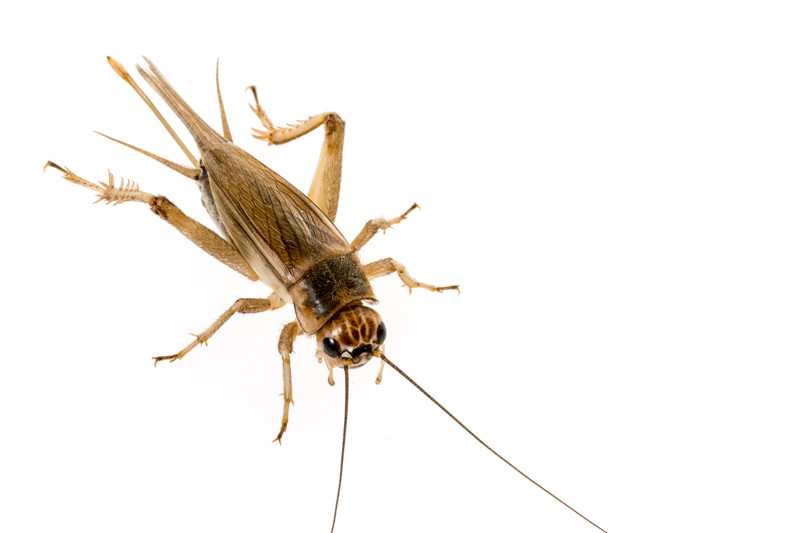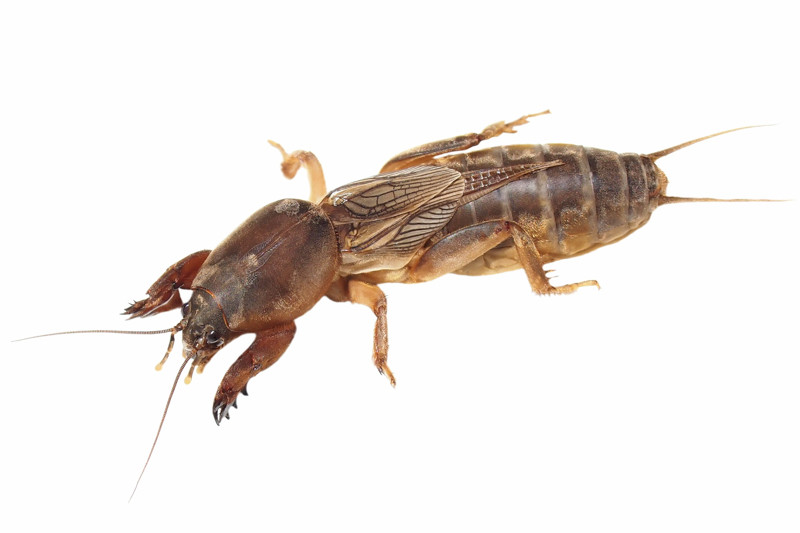How to Get Rid of Crickets in the House and Garden
Crickets are insects belonging to the order Orthoptera, which also includes grasshoppers and katydids. They are found worldwide and are well-known for their characteristic chirping sounds produced by males to attract females for mating. Crickets have a cylindrical body, long antennae, and powerful hind legs adapted for jumping.
In some cultures, crickets are considered symbols of good luck and are even kept as pets for their soothing, melodic sounds.
Additionally, crickets have gained popularity as a sustainable source of protein for both human consumption and animal feed due to their high nutritional value and low environmental impact compared to traditional livestock.
There are over 900 species of crickets, and they can be found in various habitats, such as grasslands, forests, and even urban environments.
Field crickets (Gryllus spp.): They are usually black or dark brown and can be found in grassy fields, meadows, and gardens. They are active mostly at night and are known for their loud, rhythmic chirping sounds. They are often considered beneficial insects for gardens as they help control pests and recycle nutrients.
 Field Cricket (Gryllus assimilis)
Field Cricket (Gryllus assimilis)
House crickets (Acheta domesticus): They are light brown or tan with dark brown bands on their bodies. As their name suggests, they often find their way into homes, attracted by warmth and food sources. They can become a nuisance due to their persistent chirping and potential damage to fabrics and paper products. They are widely used as live food for pets like reptiles, amphibians, and birds.
 House Cricket (Acheta domesticus)
House Cricket (Acheta domesticus)
Mole crickets (Gryllotalpidae family): They have a unique appearance compared to other crickets, with cylindrical, velvety bodies and large, shovel-like forelimbs adapted for burrowing. They live mostly underground in moist soil and create tunnels in search of food. In some cases, they can become pests in lawns, gardens, and agricultural fields due to their tunneling activity, which can damage plant roots and disrupt the soil.
 Mole Cricket (Gryllotalpidae)
Mole Cricket (Gryllotalpidae)
Crickets are attracted to a variety of factors in their environment. Some common factors include:
Food sources: Crickets are omnivorous and attracted to areas with abundant food supplies. They feed on plants, other insects, and decaying organic matter. Gardens, compost piles, and garbage bins can provide ample food sources, making these areas attractive to them.
Shelter: Crickets seek shelter in dark, protected areas where they can hide from predators and harsh weather conditions. They may be attracted to piles of leaves, grass, logs, rocks, and other debris that offer hiding spots. In residential areas, they may find shelter in cracks and crevices, basements, garages, and other secluded spaces.
Moisture: Crickets need moisture to survive and are drawn to areas with damp or humid conditions. Leaky pipes, poorly ventilated spaces, and moist soil can attract crickets in search of water.
Warmth and light: Crickets are more active in warm temperatures and are often attracted to sources of warmth, such as heated buildings or sunlit areas. They are also attracted to artificial light sources, like outdoor lighting, porch lights, and windows, which can draw them close to homes.
Mating opportunities: Male crickets are attracted to areas where they can find females for mating. They produce their characteristic chirping sounds to attract females, and the presence of other crickets can draw more crickets to the area.
To minimize the attraction of crickets to your home or garden, you can take steps like sealing cracks and gaps, removing potential hiding spots, reducing outdoor lighting at night, and maintaining proper moisture levels.
Crickets are generally not harmful to humans or pets, and they do not pose any significant health risks. In some cases, they can even be beneficial to gardens by feeding on other pests and helping to recycle nutrients through their consumption of decaying plant matter. However, there are some situations where they can be considered a nuisance or cause minor damage:
Overall, crickets are not inherently harmful, and their negative impacts are typically limited to specific situations. In many cases, their presence in gardens and natural ecosystems is beneficial and an essential part of the food chain.
Crickets are omnivorous insects, which means they have a diverse diet that includes both plant and animal matter. Their diet varies depending on the species and availability of food in their environment. Some of the common food sources include:
Plant matter: They consume various parts of plants, such as leaves, stems, fruits, seeds, and flowers. They can feed on a wide range of plants, including grasses, vegetables, and ornamental plants.
Insects and other small arthropods: They are known to prey on other insects, such as aphids, caterpillars, and small spiders, as well as other small arthropods, like mites and springtails.
Dead insects and carrion: They can also scavenge on dead insects and other small animals, making use of this readily available food source.
Organic debris: They often feed on decaying organic matter, such as dead plant material, leaf litter, and fungi.
Pet food: In household environments, they may be attracted to pet food that is left out overnight, feeding on both dry and wet varieties.
Crickets are opportunistic feeders and will consume a wide range of food sources depending on what is available in their environment. This adaptable diet allows them to thrive in a variety of habitats, including gardens, forests, grasslands, and even urban areas.
Getting rid of house crickets involves a combination of prevention and control measures. Here are some steps you can take to eliminate them from your home:
1. Seal entry points: Inspect the exterior of your home for cracks, gaps, and holes where crickets can enter. Seal these openings using caulk, weather stripping, or other appropriate materials to prevent them from getting inside.
2. Remove hiding places: Keep your home clean and clutter-free, especially in basements, attics, and storage areas where crickets may hide. Remove piles of paper, cardboard boxes, and other potential hiding spots.
3. Eliminate food sources: Store food in sealed containers, clean up spills and crumbs promptly, and avoid leaving pet food out overnight to eliminate food sources.
4. Reduce moisture: Repair leaky pipes, use a dehumidifier in damp areas, and ensure proper ventilation to minimize moisture levels in your home, making it less attractive to them.
5. Vacuum regularly: Regularly vacuum your home, paying special attention to corners, baseboards, and other areas where crickets may hide. This can help remove any crickets or their eggs.
6. Sticky traps: Place sticky traps or glue boards along walls, baseboards, and other areas where you’ve noticed cricket activity. These traps will capture crickets as they walk over them.
7. Cricket baits:
Cricket bait is a useful method for capturing crickets, especially when dealing with a large number of these insects in your home or garden. The bait attracts crickets, luring them into a trap where they can be easily removed. Using molasses bait traps is an effective, eco-friendly method to catch crickets and reduce their populations in your living space. Here’s how to create a simple cricket bait trap:
8. Cut back vegetation:
Cutting back vegetation can be an effective way to reduce cricket populations and discourage them from infesting your property. Crickets are attracted to moist, dark, and protected areas, which can often be found in dense vegetation, tall grasses, and garden debris. Here’s how cutting back vegetation can help get rid of them:
9. Reduce bright lights:
Crickets are attracted to bright lights, especially at night. Many cricket species are nocturnal and use light sources as navigation aids. By removing or reducing bright lights around your home, you can make your property less appealing to crickets and help get rid of them. Here are some steps you can take:
By reducing or eliminating bright lights around your home, you can make your property less appealing to crickets, helping to get rid of them.
10. Insecticides: If the infestation is severe, consider using insecticides specifically labeled for cricket control. Apply the insecticide according to the product label instructions, targeting areas where they are most active. Always follow safety precautions when using chemical insecticides.
11. Professional help: If you’re unable to control the cricket infestation on your own, consider hiring a professional pest control service to assess the situation and provide appropriate treatment options.
Getting rid of mole crickets requires a combination of preventive measures, cultural controls, and chemical treatments. Here are some steps you can take to eliminate them from your lawn or garden:
1. Monitor your lawn: Regularly inspect your lawn for signs of mole cricket activity, such as raised tunnels or spongy areas in the soil. Early detection is crucial for effective control.
2. Biological control: Introduce natural predators like nematodes (Steinernema scapterisci) or parasitic wasps (Larra bicolor) that specifically target mole crickets. These beneficial organisms can help reduce mole cricket populations without harming other organisms.
3. Cultural controls:
4. Mechanical controls: In small areas or for light infestations, you can handpick mole crickets or use a garden hose to flush them out of their tunnels. Dispose of them in a bucket of soapy water.
5. Baiting: Apply mole cricket-specific baits that contain insecticides such as carbaryl or fipronil. Follow the product label instructions for proper application and timing. Baits are typically more effective during the nymph stage when mole crickets are actively feeding.
6. Insecticides: If the infestation is severe, consider using liquid insecticides labeled for mole cricket control, such as bifenthrin, imidacloprid, or permethrin. Apply these chemicals according to the product label instructions, targeting the areas with the most mole cricket activity. Timing is critical, and the best results are typically achieved when targeting the nymph stage, usually in late spring or early summer.
7. Professional help: If you cannot control the mole cricket infestation on your own or if the problem is widespread, consider hiring a professional pest control service to assess the situation and provide appropriate treatment options.
By using a combination of these methods, you can reduce mole cricket populations and minimize damage to your lawn or garden. Remember that consistency and timing are key factors in effectively controlling mole crickets.
Crickets and grasshoppers are both insects belonging to the order Orthoptera, but they have several differences in appearance, behavior, and habitat.

Appearance:
Behavior:
Habitat:
Diet:
xpixel, encikAn, Kuttelvaserova Stuchelova, Ernie Cooper, Shutterstock
Create a membership account to save your garden designs and to view them on any device.
Becoming a contributing member of Gardenia is easy and can be done in just a few minutes. If you provide us with your name, email address and the payment of a modest $25 annual membership fee, you will become a full member, enabling you to design and save up to 25 of your garden design ideas.
Join now and start creating your dream garden!
Create a membership account to save your garden designs and to view them on any device.
Becoming a contributing member of Gardenia is easy and can be done in just a few minutes. If you provide us with your name, email address and the payment of a modest $25 annual membership fee, you will become a full member, enabling you to design and save up to 25 of your garden design ideas.
Join now and start creating your dream garden!